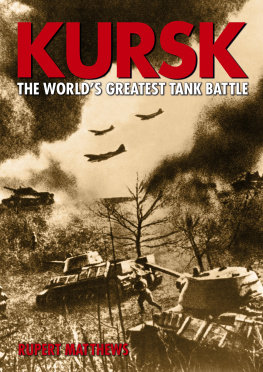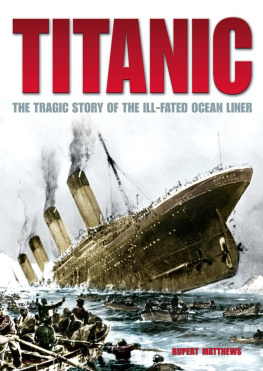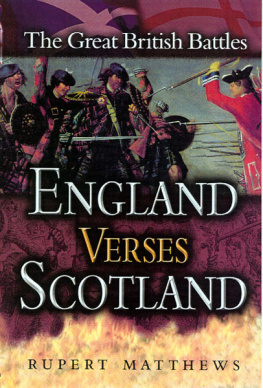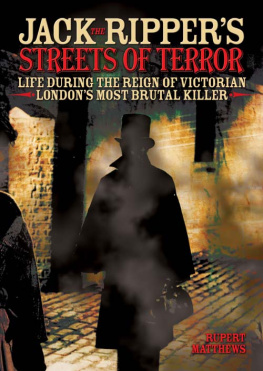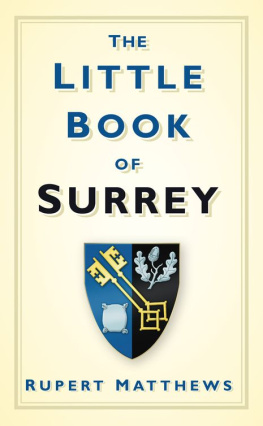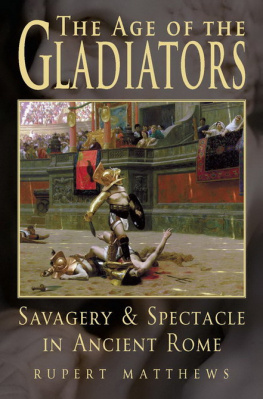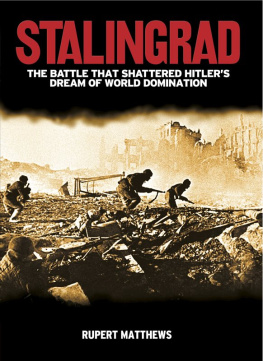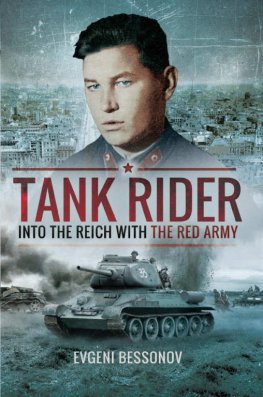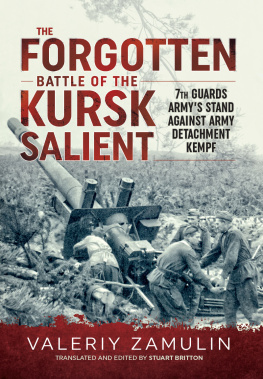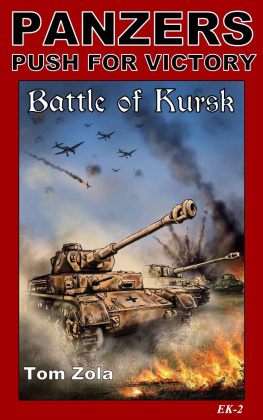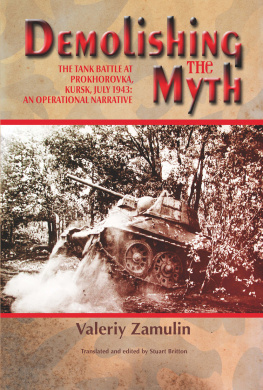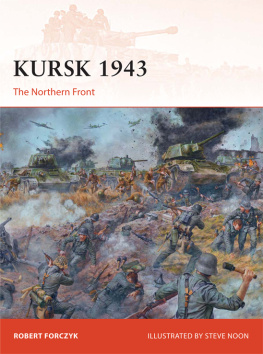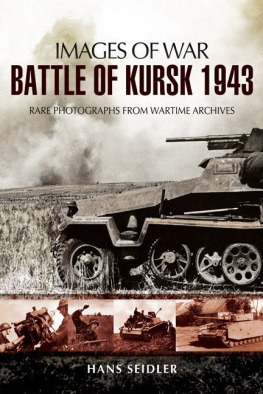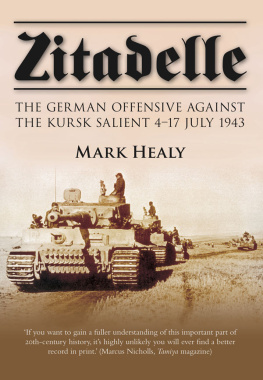Chapter 1
The Citadel
The planning for what was to become the German Operation Zitadelle (Citadel), the Battle of Kursk, was long in coming and slow in formation. It grew out of a desire to do something on the Eastern Front, combined with the knowledge that the losses at Stalingrad meant that a major war-winning offensive was impossible.
In part the disastrous decision to launch the Battle of Kursk grew out of the increasingly confused German command structure, combined with the personalities of the men involved. In theory the German High Command had a clear and relatively simple structure.
Command structure
At the top was Adolf Hitler himself as Fhrer and supreme warlord of Germany. Hitler, however, was also the head of the government of Germany, so in practice the command of the armed forces was in the hands of military professionals. At first Hitler took an interest and sometimes overruled the professionals, but as the years passed his involvement grew rapidly.
The top organization in the German armed forces was the Oberkommando der Wermacht, Supreme Command of the Armed Forces, usually termed OKW. This was the overall strategic planning body that made the big strategic decisions, allocated resources between the army, air force and navy and liaised with the suppliers and manufacturers who designed and produced weaponry.
The chief of OKW was Field Marshal Wilhelm Keitel, who had taken over the post in 1939 and would hold it until 1945. Keitel was a successful and talented career army officer, though some of his colleagues suspected that his elevation to the supreme command in 1939 had more to do with his admiration for Hitler than his military skills.
Under OKW were the supreme command bodies of the army, air force and navy. The body commanding the army was Oberkommando des Heeres, or OKH. In 1939 the OKH was led by another talented career officer Walther von Brauchitsch. Brauchitsch oversaw the German Army during the Polish and French campaigns, and the early months of the Russian war. However in November 1941 he suffered a heart attack, which made him an ideal scapegoat for the failure to capture Moscow. Hitler sacked Brauchitsch, then took the unprecedented step of assuming the position of head of OKH himself.
This created the anomalous position in which Hitler was supreme warlord and dictator of Germany, while at the same time being head of the army and so in theory subordinate to Keitel. In practice Hitler and OKH came to have command of all forces in the war against Russia, while OKW dealt with everywhere else.
In fact, OKH was dependent on Hitler mostly for strategic direction. The nitty gritty of its tasks was in the hands of Kurt Zeitzler. Zeitzler was a master of the often tedious business of logistics. He could organize supplies to be moved across great distances with remarkable speed and knew how much petrol a panzer division would need to keep fighting. Zeitzler knew his business and how to achieve it, and when dealing with these sorts of technical matters was one of the few men who regularly stood up to Hitler. The two had some fiery disputes, after some of which Hitler backed down.
Under OKH the Eastern Front was in the hands of three large commands. Army Group North was commanded by Field Marshal Georg von Kchler. It comprised the 16th Army and 18th Army and was relatively inactive. The siege of Leningrad was its main concern. The siege had begun in September 1941 and was still dragging on in early 1943. Elsewhere along his line, von Kchler lacked the resources to do anything much other than dig in and hope the Russians did not attack.
Army Group Centre was commanded by Gnther von Kluge and was a substantially more powerful force comprising 2nd Panzer Army, 3rd Panzer Army, 4th Army, 9th Army and LIX Army Corps. It held the line from Smolensk to Orel and had been responsible for protecting the northern flank of the advance that ended at Stalingrad. Its units were well equipped, rested and up to full complement.
Army Group South was in the process of reorganizing in January 1943. It was commanded by Erich von Manstein, one of Germanys most talented senior generals. The units of Army Group South were exhausted after the fighting of 1942, short on equipment and lacking supplies. Its key 6th Army was bottled up in Stalingrad, and on 2 February it surrendered.
A fourth major unit, Army Group A was in the Crimea and neighbouring areas of the Kuban to the south of Mansteins Army Group South. This smaller unit was commanded by Paul von Kleist. Manstein and Kleist bickered over the boundaries between their commands and who should have control of which units. Hitler came down on the side of Kleist because he wanted to keep a firm grip on the Crimea, which blocked a Soviet advance on key oilfields that were supplying the German war effort.
On 6 February Hitler summoned Manstein to OKH for a meeting. Manstein approached the meeting with some foreboding. His army group was in something of a mess and he had been taking chances, not all of which had paid off. Most concerning of all was the fact that Manstein had recently developed his own idosyncratic way of dealing with OKH. Manstein had noticed that Hitler and OKH rarely flatly turned down a request. If a general suggested something with which Hitler did not agree, OKH simply refused to respond. This way, whether the general took the suggested action or not, he could be blamed if things went wrong. Manstein had adopted the ruse of ending each request with a sentence stating that unless he heard from OKH by a set date that they disagreed he would assume that they were giving him permission to do whatever he suggested. In this way, Manstein had been able to retreat, counter-attack and reform his units as he wished.
Now Hitler wanted to see him and had sent an aircraft to carry him to the meeting. Other generals had answered a similar summons only to find themselves summarily sacked.
In fact Manstein found Hitler in calm and contemplative mood. Drawing on reports from OKH staff, Hitler filled Manstein in on the logistical situation, particularly the production figures of new armoured vehicles, before moving on to discuss the military situation in Mansteins command area. Several different options were discussed. Manstein emphasized the weakness of his forces and the vast front that he was expected to hold. Eventually Hitler gave Manstein permission to withdraw men from some isolated positions, but insisted that the two cities of Kharkov and Kursk should be held. The meeting ended amicably, after which Manstein returned to his own headquarters.
Soviet movements
So long as the German 6th Army had held out in Stalingrad, the Soviets had kept the bulk of their forces around that unhappy city. Once the Germans surrendered, the Soviets were free to move their armies against the main front. The attack began at Voronezh, where the Soviets broke through a section of front held by the Hungarians and began pushing west toward the town of Kursk. Another assault began further south at Millerovo. Again the Soviets broke through the sparsely held front line and drove west between the Don and Donetz toward the industrial city of Kharkov.
Driving onwards across weakly protected steppes, the Russians next thrust forwards to produce a salient between Orel and Kursk, a few days after a second thrust had outflanked Kursk to the south; not long afterwards, the city of Kursk duly fell to the Soviets.
The fall of Kursk formed a huge bulge in the line north of Kharkov, which was quite clearly going to be the Soviets next target. Kharkov was held by what on paper looked like a formidable force. Three elite SS Panzer divisions the Leibstandarte, Das Reich and Totenkopf were positioned around the city under the command of General Hubert Lanz. However, the units were short on supplies, and communications with Mansteins headquarters had broken down.

